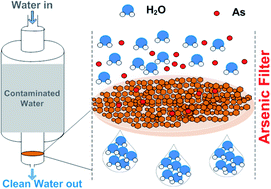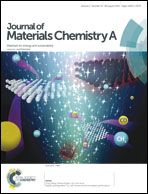Ultra-long magnetic nanochains for highly efficient arsenic removal from water†
Abstract
The contamination of drinking water with naturally occurring arsenic is a global health threat. Filters that are packed with adsorbent media with a high affinity for arsenic have been used to de-contaminate water—generally iron or aluminium oxides are favored materials. Recently, nanoparticles have been introduced as adsorbent media due to their superior efficiency compared to their bulk counter-parts. An efficient nanoadsorbent should ideally possess high surface area, be easy to synthesize, and most importantly offer a high arsenic removal capacity. Achieving all the key features in a single step synthesis is an engineering challenge. We have successfully engineered such a material in the form of nanochains synthesized via a one step flame synthesis. The ultra-long γ-Fe2O3 nanochains possess high surface area (151.12 m2 g−1), large saturation magnetization (77.1 emu g−1) that aids in their gas phase self-assembly into long chains in an external magnetic field, along with an extraordinary arsenic removal capacity (162 mg g−1). A filter made with this material exhibited a relatively low-pressure drop and very little break-through of the iron oxide across the filter.


 Please wait while we load your content...
Please wait while we load your content...